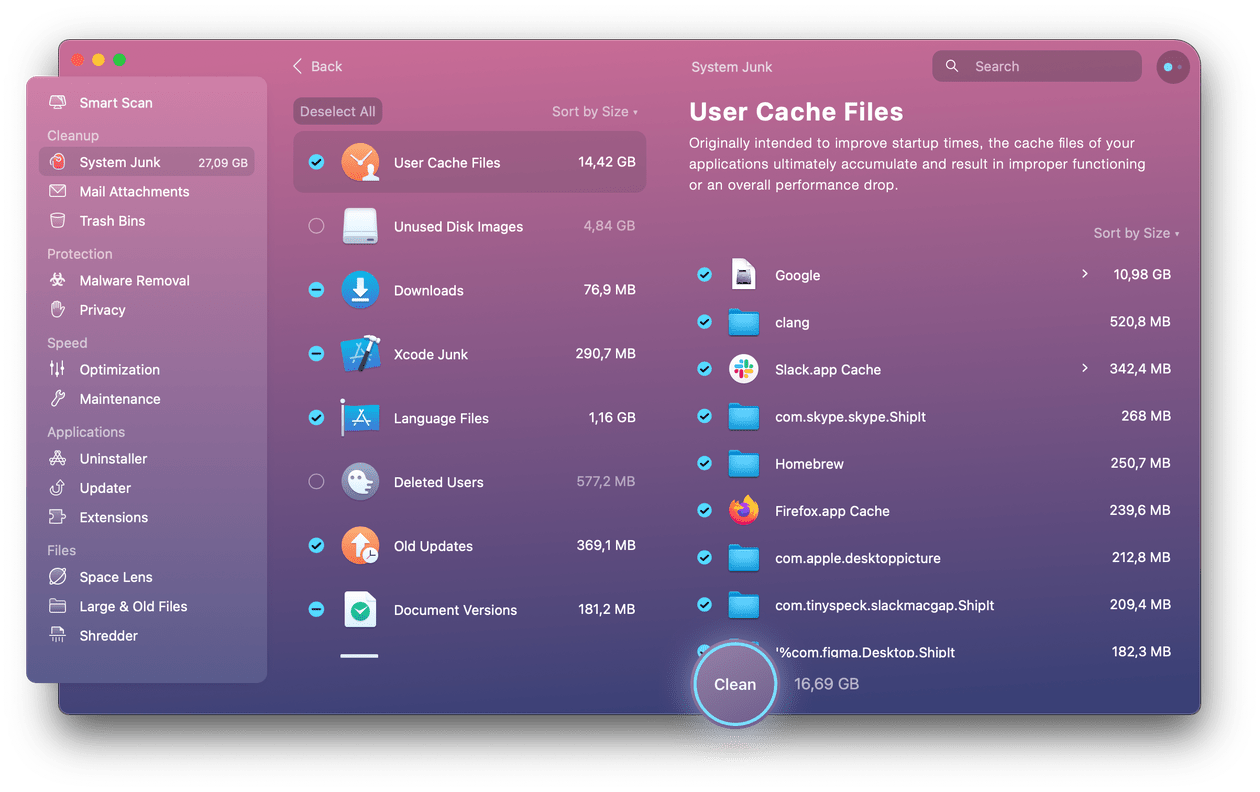Jun 27, 2021 9:46 AM
- Save space on your Mac by storing your content in iCloud, using built-in tools to find and remove large files, or manually deleting apps, files, and more.
- Free up some much-needed space on your Mac and delete as many of these old download files as possible, and remember to come back and tidy it up every few months. CleanMyMac can help for sure. But also, consider switching your email client to Unibox, which automatically reduces excessive downloads.
Jan 10, 2020 Here's how to open Library, so we can start to discover what 'other' is on Mac: Open Finder. Select 'Go' from menu. Hold down 'option' key on keyboard; you should see a new option for 'Library'. While holding down the option key, select 'Library'. You'll see a Library folder in the list. Click it to see all your apps and associated files. Disk Space Analyzer is not only a hard drive space visualizer but also a storage space cleaner. Besides the option to show the disk usage map, it can be used to quickly free up disk space on Mac. The application shows the size and other information for specific files and folders just by moving your mouse over the charts sections.
Etrecheck can help you identify background applications. Post your Etrecheck results to the communities to get assistance removing unnecessary background applications:

https://www.devontechnologies.com/apps/freeware EasyFind can locate files without the help of Spotlight's index both hidden and otherwise.
http://www.reggieashworth.com/appdelete.html AppDelete
Xbox live gamertag ip grabber download04. is the uninstaller that when you drag and drop applications over its window, it can locate and remove all related files in safe mode (boot with the shift key).
Note: Symantec Endpoint protection has its own uninstaller, which you will need to contact Broadcom support to reset its security password if you forgot it to remove it. That's independent of the system password.
Jun 27, 2021 9:46 AM
The Optimised Storage features of your Mac help you save storage space by storing your content in iCloud and making it available on demand:
- When storage space is needed, files, photos, films, email attachments and other files that you rarely use are stored in iCloud automatically.
- Each file stays exactly where you last saved it, and will be downloaded when you open it.
- Files that you’ve used recently remain on your Mac, along with optimised versions of your photos.
If you haven't yet upgraded to macOS Sierra or later, learn about other ways to free up storage space.
Find out how much storage is available on your Mac

How To Free Up Other On Mac Hard Drive
Choose Apple menu > About This Mac, then click Storage. Each segment of the bar is an estimate of the storage space used by a category of files. Move your pointer over each segment for more detail.
Click the Manage button to open the Storage Management window, pictured below.
Manage storage on your Mac
The Storage Management window offers recommendations for optimising your storage. Shanghai card game score sheet. If some recommendations are already turned on, you will see fewer recommendations.
Store in iCloud
Click the Store in iCloud button, then choose from these options:
- Desktop and Documents. Store all files from these two locations in iCloud Drive. When storage space is needed, only the files you recently opened are kept on your Mac, so that you can easily work offline. Files stored only in iCloud display a download icon , which you can double-click to download the original file. Learn more about this feature.
- Photos. Store all original, full-resolution photos and videos in iCloud Photos. When storage space is needed, only space-saving (optimised) versions of photos are kept on your Mac. To download the original photo or video, just open it.
- Messages. Store all messages and attachments in iCloud. When storage space is needed, only the messages and attachments you recently opened are kept on your Mac. Learn more about Messages in iCloud.
Storing files in iCloud uses the storage space in your iCloud storage plan. If you reach or exceed your iCloud storage limit, you can either buy more iCloud storage or make more iCloud storage available. iCloud storage starts at 50GB for US$0.99 a month, and you can purchase additional storage directly from your Apple device. Find out more about prices in your region.
Optimise Storage
Click the Optimise button to save space by automatically removing films and TV shows you've watched. When storage space is needed, films or TV shows that you've purchased from Apple and have already watched will be removed from your Mac. Click the download icon next to a film or TV show to download it again.
Your Mac will also save space by only keeping recent email attachments on this Mac when storage space is needed. You can manually download any attachments at any time by opening the email or attachment, or saving the attachment to your Mac.
Optimising storage for films, TV shows and email attachments doesn't require iCloud storage space.
Empty Bin Automatically
Empty Bin Automatically permanently deletes files that have been in the Bin for more than 30 days.
Reduce Clutter
Reduce Clutter helps you identify large files and files you might no longer need. Click the Review Files button, then choose any of the file categories in the sidebar, such as Applications, Documents, Music Creation or Bin. Mdsolids for mac.
You can delete the files in some categories directly from this window. Other categories show the total storage space used by the files in each app. You can then open the app and decide whether to delete files from within it.
Find out how to redownload apps, music, films, TV shows and books.
Where to find the settings for each feature
The button for each recommendation in the Storage Management window affects one or more settings in other apps. You can also control those settings directly within each app.
- If you're using macOS Catalina or later, choose Apple menu > System Preferences, click Apple ID, then select iCloud in the sidebar: Store in iCloud turns on the Optimise Mac Storage setting on the right. To turn off iCloud Drive entirely, untick iCloud Drive.
- If you're using macOS Mojave or earlier, choose Apple menu > System Preferences, click iCloud, then click Options next to iCloud Drive. Store in iCloud turns on the Desktop & Documents Folders and Optimise Mac Storage settings.
- In Photos, choose Photos > Preferences, then click iCloud. Store in iCloud selects iCloud Photos and Optimise Mac Storage.
- In Messages, choose Messages > Preferences, then click iMessage. Store in iCloud selects Enable Messages in iCloud.
- If you're using macOS Catalina or later, open the Apple TV app, choose TV > Preferences from the menu bar, then click Files. Optimise Storage selects “Automatically delete watched films and TV shows'.
- If you're using macOS Mojave or earlier, open iTunes, choose iTunes > Preferences from the menu bar, then click Advanced. Optimise Storage selects “Automatically delete watched films and TV shows”.
- In Mail, choose Mail > Preferences from the menu bar, then click Accounts. In the Account Information section on the right, Optimise Storage sets the Download Attachments menu to either Recent or None.
Empty Bin Automatically: From the Finder, choose Finder > Preferences, then click Advanced. Empty Bin Automatically selects “Remove items from the Bin after 30 days”.
Other ways that macOS helps automatically save space

Other Category Taking Up Storage On Mac
With macOS Sierra or later, your Mac will automatically take these additional steps to save storage space:
How To Free Up Other On Mac Browser
- Detects duplicate downloads in Safari, keeping only the most recent version of the download
- Reminds you to delete used app installers
- Removes old fonts, languages and dictionaries that aren't being used
- Clears caches, logs and other unnecessary data when storage space is needed
How to free up storage space manually
How To Free Up Other On Mac
Even without using the Optimised Storage features described in this article, you can take other steps to make more storage space available:
How To Free Up Other On Mac Desktop
- Music, films and other media can use a lot of storage space. Learn how to delete music, films and TV shows from your device.
- Delete other files that you no longer need by moving them to the Bin, then emptying the Bin. The Downloads folder is good place to look for files that you might no longer need.
- Move files to an external storage device.
- Compress files.
- Delete unneeded email: In the Mail app, choose Mailbox > Erase Junk Mail. If you no longer need the email in your mailbox, choose Mailbox > Erase Deleted Items.
Learn more
- The Storage pane of About This Mac is the best way to determine the amount of storage space available on your Mac. Disk Utility and other apps may display storage categories, such as Not Mounted, VM, Recovery, Other Volumes, Other, Free or Purgeable. Don't rely on these categories to understand how to free up storage space or how much storage space is available for your data.
- When you duplicate a file on an APFS-formatted volume, that file won't use additional storage space on the volume. Deleting a duplicate file frees up only the space required by any data you might have added to the duplicate. If you no longer need any copies of the file, you can recover all of the storage space by deleting both the duplicate and the original file.
- If you're using a pro app and Optimise Mac Storage, learn how to make sure that your projects are always on your Mac and able to access their files.